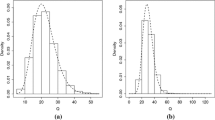Summary
In the linear calibration problem, a model is fit to paired observations arising from two measurement techniques, one known to be far more accurate (but also more expensive) than the other. The fitted model is then used with univariate observations from the less accurate technique to impute values from the more accurate one. The Bayesian paradigm emerges as attractive in this context, but the choice of an appropriate noninformative prior distribution has been controversial. In this paper we derive a class of such distributions, and provide sufficient conditions under which they lead to proper posterior densities. These priors, which we refer to asprobability matching priors, are designed to produce posterior credible intervals which are asymptotically identical to their frequentist counterparts. We provide details on the implementation of our procedure using sampling-based methods, and obtain significant simplifications over previous Bayesian approaches in this area. We compare the performance of several members of our prior class in the context of two illustrative examples.
Similar content being viewed by others
References
Berger, J. O. and Bernardo, J. M. (1989) Estimating a product of means: Bayesian analysis with reference priors.J. Amer. Statist. Assoc. 84, 200–207.
Berger, J. O. and Bernardo, J. M. (1992a). On the development of reference priors.Bayeslan Statistics 4 (J. M. Bernardo, J. O. Berger, A. P. Dawid and A. F. M. Smith, eds.). Oxford: University Press, 35–60, (with discussion).
Berger, J. O. and Bernardo, J. M. (1992b). Ordered group reference priors with application to the multinomial problem.Biometrika 79, 25–37.
Berkson, J. (1969). Estimation of a linear function for a calibration line: consideration of a recent proposal.Technometrics 11, 649–660.
Bernardo, J. M. (1979). Reference posterior distributions for Bayesian inference.J. Roy. Statist. Soc. B 41, 113–147, (with discussion).
Brown, P. J. (1982). Multivariate calibration.J. Roy. Statist. Soc. B,44, 287–321, (with discussion).
Brown, P. J. (1993).Measurement, Regression, and Calibration, Oxford: Clarendon Press.
Dahiya, R. C. and McKeon, J. J. (1991). Modified classical and inverse regression estimators in calibration.Sankhyã, Ser. B 53, 48–55.
Datta, G. S. and Ghosh, J. K. (1995a). On priors providing frequentist validity for Bayesian inference.Biometrika 82, 37–45.
Datta, G. S. and Ghosh, J. K. (1995b). Noninformative priors for maximal invariant parameters in group models.Test 4, 95–114.
Datta, G. S. and Ghosh, M. (1996). On the invariance of noninformative priors.Ann. Statist., (to appear).
Eisenhart, C. (1939). The interpretation of certain regression methods and their use in biological and statistical research.Ann. Math. Statist. 10, 162–184.
Fieller, E. C. (1954). Some problems in interval estimation.J. Roy. Statist. Soc. B 16, 175–185.
Gelfand, A. E. and Smith, A. F. M. (1990). Sampling-based approaches to calculating marginal densities.J. Amer. Statist. Assoc. 85, 398–409.
Gelman, A. and Rubin, D. B. (1992).Statist Sci. 7, 457–511, (with discussion).
Ghosh, J. K. and Mukerjee, R. (1992). Non-informative priors.Bayesian Statistics 4 (J. M. Bernardo, J. O. Berger, A. P. Dawid and A. F. M. Smith, eds.), Oxford: University Press, 195–210, (with discussion).
Gilks, W. R. and Wild, P. (1992). Adaptive rejection sampling for Gibbs sampling.Applied Statistics 41, 337–348.
Gleser, L. J. and Hwang, J. T. (1987). The nonexistence of 100(1−α)% confidence sets of finite expected diameter in errors-in-variables and related models.Ann. Statist. 15, 1351–1362.
Hill, B. M. (1981). Discussion of “A Bayesian analysis of the linear calibration problem”.Technometrics 23, 335–338.
Hoadley, B. (1970). A Bayesian look at inverse linear regression.J. Amer. Statist. Assoc. 65, 356–369.
Hunter, W. G. and Lamboy, W. F. (1981). A Bayesian analysis of the linear calibration problem.Technometrics 23, 323–350, (with discussion).
Jeffreys, H. (1961).Theory of Probability, 3rd Oxford: Clarendon Press.
Krutchkoff, R. G. (1967). Classical and inverse regression methods of calibration.Technometrics 9, 429–439.
Kubokawa, T. and Robert, C. (1994). New perspectives on linear calibration.J. Multivariate Analysis 50, 178–200.
Lawless, J. F. (1981). Discussion of “A Bayesian analysis of the linear calibration problem”.Technometrics 23, 334–335.
Liseo, B. (1993). Elimination of nuisance parameters with reference priors.Biometrika 80, 295–304.
Loève, M. (1955).Probability Theory. New York: D. Van Nostrand Company.
Peers, H. W. (1965). On confidence sets and Bayesian probability points in the case of several parameters.J. Roy. Statist. Soc. B 27, 9–16.
Philippe, A. and Robert, C. (1994). A note on the confidence properties of reference priors for the calibration model.Tech. Rep., Université de Rouen.
Reid, N. (1996). Likelihood and Bayesian approximation methods.Bayesian Statistics 5 (J. M. Bernardo, J. O. Berger, A. P. Dawid and A. F. M. Smith, eds.). Oxford: University Press, 349–366, (with discussion).
Stein, C. (1985). On the coverage probability of confidence sets based on prior distributions.Sequential Methods in Statistics, Banach Center Publications Vol. 16. Warsaw: Polish Scientific Publishers, 485–514.
Tibshirani, R. (1989). Noninformative priors for one parameter of many.Biometrika 76, 604–608.
Welch, B. L. and Peers, H. W. (1963). On formulae for confidence points based on intervals of weighted likelihoods.J. Roy. Statist. Soc. B 25, 318–329.
Williams, E. J. (1969). A note on regression methods in calibration.Technometrics 11, 189–192.
Author information
Authors and Affiliations
Rights and permissions
About this article
Cite this article
Ghosh, M., Carlin, B.P. & Srivastava, M.S. Probability matching priors for linear calibration. Test 4, 333–357 (1995). https://doi.org/10.1007/BF02562631
Received:
Revised:
Issue Date:
DOI: https://doi.org/10.1007/BF02562631




